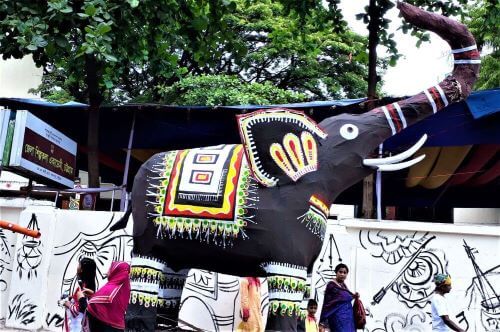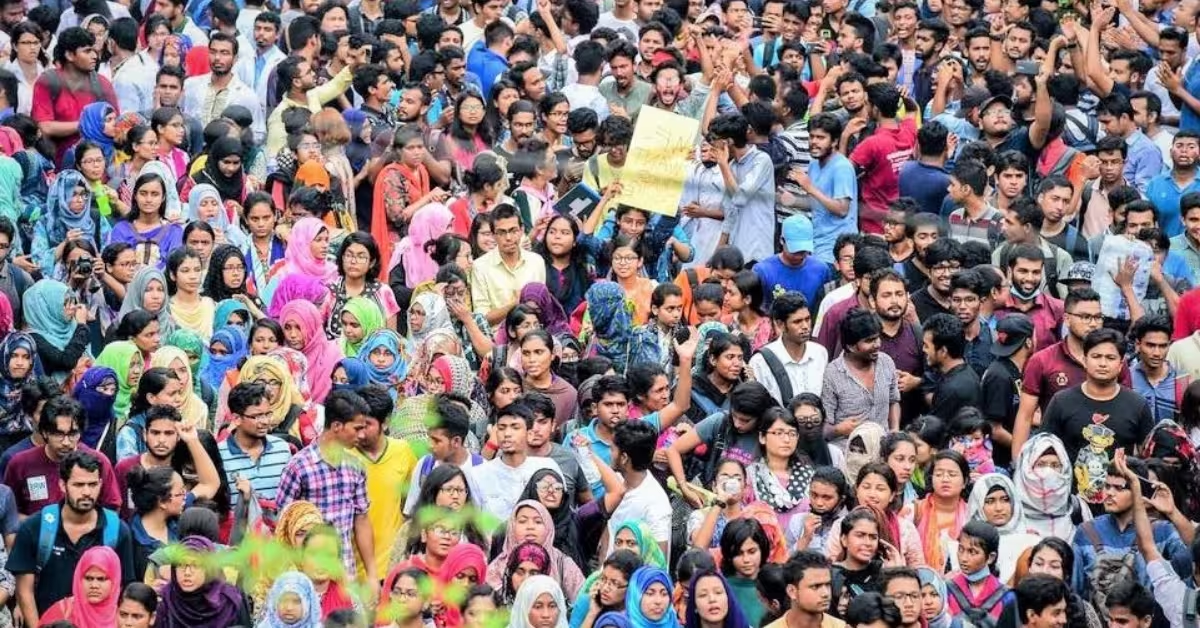Last updated on May 9th, 2025 at 11:27 pm
The way cultural globalization and value erosion in Bangladesh are reshaping the lifestyle of people is unprecedented.
The tastes and values are so bound to radical alteration that the generational conflict between the old and the new is unavoidable. Bangladeshis’ cultural celebrations, Pahela Boishaksh, for example, are to encounter a double threat for survival: one from locally grown funambulism while others through the importation of foreign culture that often permeates through globalization.
Let us begin the journey with a little bit of nitty-gritty of the New Year celebration of different cultures.
Table of Contents
Our culture is our honour

Bangladeshi culture is known as Bengali Culture which is based on a brilliant taste in fine arts, humanities and knowledge.
It is an integrated pattern of human knowledge, behaviour, beliefs, customs, morals, conventions, shared attitudes, social organisation and achievements. it is approximately eight hundred years, or at best one thousand years old. rice, the staple food of the Bangalis, was first cultivated at least three thousand years before the advent of the Aryans to this region; and it continued to be cultivated later even when Bengal was swept away by a host of invaders, including the Aryans, Turks, Arabs, Afghans, Mughals and Europeans.
Bengali culture is the outcome of the accumulation and synthesis of many different ethnic and religious groups and subgroups and varied classes interacting and influencing each other for centuries.
The coexistence and continuation of disparate elements of culture for centuries have created a unique Bangaliness, and defined as the culture of “Bengal” and of the Bengali-speaking people. It seems that Hinduism and Buddhism made their way to Bengal roughly at the same time ‘ a few centuries before Christ, and gradually replaced and influenced the existing religions and beliefs of the land.
The Muslim invader, Muhammad bin Bakhtiyar Khalji, a Turko-Afghan military general, who defeated Lakshmana Sena in 1204, ruler from the Sena Dynasty, established Muslim rule in Bengal and brought about a huge wave of change. Many Muslim preachers who, with an amount of royal support, followed him and enthusiastically took the job of converting the local Bangali people.
Even though the figure of Muslim conversion in the processing two years is not known, the number of Buddhists rapidly dwindled and the building of Hindu temples came to a halt.
Whether Buddhists converted to Islam en mass to take shelter from the oppression of the Hindu hierarchical caste system which the Senas had strengthened is a matter of conjecture. There was also a large-scale conversion among low-caste Hindus to Islam. By the seventeenth century, Islam, like the earlier Buddhism and even Hinduism, took a syncretistic Bengali character and people from the lowest strata of society flocked to Islam in large numbers.
Culture variations

Pahela Boishakh festivity marks the beginning of Bengali New Year which is celebrated on April 14 every year.
Like the African celebration of African New Year on September 11, Chinese New Year on January 20-February 20 (February 16 this year), Cambodian New Year on April 13 0r 14, Thai New Year on April 13 of 14; European New Year on January 13 according to Gregorian Calendar, Bangalee in West Bengal and Bangladesh Celebrated Bengali New Year, Pahela Boishakh on April 14.
The celebration of the New Year is followed by many festivities which was initiated during the Mesopotamian Civilisation in two millennium BCE. Even though historians are doubtful about the Bengali New Year’s inception some historians still tend to say that it came into being during the Mughal reign, and was introduced by Emperor Akbar who ordered the astronomer Fathullah Siraji to create a calendar combing the Muslim lunar and Hindu solar calendar: lunisolar. The emperor asked for a new calendar because the Hijra Muslim Calendar did not coincide with the agricultural cycle. The calendar was made keeping Baishakh as the first month of the twelve.
In the same vein, we do not grow old to our culture and cultural values in the sense that it helps us discover our old self of sweet old days.
Cambridge English Dictionary defines culture as ‘the custom and beliefs, art, way of life and special organisation of a particular country or group’.
Anthropologist E.B. Taylor says ‘it is that complex whole which includes, knowledge, belief, art, morals, law, customs and any other capabilities, habits acquired by man as a member of society’. German usage of culture refers to ‘symbols and values’
Archaeologists describe the wholeness of societies by differentiating culture in ‘material culture, and adaptive culture’ or non-material. Material culture includes the usage, consumption, creation, and trade of objects as well as the behaviours, norms, and rituals that the objects create or take part in. Likewise, Bengali culture is also a composition of specific cultural traits such as language, literature, ideals, education, norms, values, law and order and so on.
Procession wearing cultural masks and dresses carrying effigies early in the morning known as Mangal Shuvazatra, or purification procession bears cultural significance.
Bengali culture is hamstrung if the celebration of the Bengali New Year is given up as any Briton will not be able to define himself as one if he had to bequeath his long-cherished culture. It is an invaluable medium of shaping our psych of individually stipulated morals, art and literature and philosophy through social production. Without it, we are nothing but rootless beings fulfilling the purpose of filling up a vacuum of existence instead of fulfilling the aim of diverse excogitation.
With the bizarre way of celebrating New Year in different countries and cultures, such as, Estonian people eat seven times a day, Panama citizens burn an effigy of everyone, Siberian jump into a frozen lake, Chileans spend a night in the cemetery with their dead loved ones, Romanians try to communicate with cattle, old furniture are thrown out of windows by Africans, Danish jump from the chair to bring new year, Peruvians do fist fighting, South African wear coloured undergarments in order to bring good luck, the celebration of Bengali New Year involves plenty of occasions and festivities.
During their New Year celebration, Sri Lankans are, according to tradition, encouraged to refrain from material pursuits and engage solely in either religious activities or traditional games, while Vietnamese usually return to their ancestral families during the celebration of their New Year, Tet. Japanese clean their houses on the last day of the o the year, 31 December, Omisoka. Traditional Rakhine people observe Thingyan by the sprinkling of scented water in a silver bowl using stems of Jambul, an evergreen tropical tree.
The sprinkling of water is done to metaphorically “wash away” one’s sins of the previous year.
The first and foremost thing that Bangali can conceptualise on their to-do list is Panta Bhat (soaked rice in water) with fried hilsa cutlet and green chillies- which is a nearly inconceivable arrangement in an urban setting because of the cost it demands.
Reciting Rabindranath Tagore’s poetry, and performing Rabindra Music is a must. Alongside the soaked rice, the celebration is followed by Baishakhi Fairs brimming with numerous Bengali traditional useful household equipment. Age-old mud-wrestling, bullfighting, boat race (in a rural setting), drawing murals and motifs, folk dramas, and folks’ songs are integral parts of Bangladeshi culture.
My visit to this year’s Baishakhi Fairs was indeed to revitalise the sense of Bengali fervour. After quite a long time I decided to revive my childhood memory around the celebration in remote Bangladesh. The memory of going to fair holding my father’s hand, buying goodies, savouring mud-wrestling, colourful festivity, the deafening sound of crowded people, trying luck with the lottery, frightening ride on wooden merry-go-round rides, getting lost in the crowds and heading home alone and having been reprimanded by parents are all I needed to be recollected.

This is the only rumination of my past that makes me feel more of a Bengali while it helps strengthen my bond with my culture. The passion for cultural functionality has been an act of duty without care.
1. Threats of globalization on cultures

The United Nations research carried out by Bahira Sherif Trask, PhD defined globalization as “to define globalization, mainstream approaches tend to focus on its economic nature and the processes that encourage nations, businesses and individuals to become integrated into the global market.
Therefore, globalization is commonly understood to be a primarily uncontrollable force that encourages a free-market ideology and perpetuates the transnational movement of capital, labour, and goods. From a wider perspective, globalization is associated with transnational phenomena and new forms of bridging geographic and cultural distances”. While the cultural invasion of globalization is inevitable, it is a matter of exigency that we take a strong stand to hold on to the age-old culture regardless of religious, ethnic, ideological, political and financial discrepancies.
Our sovereignty remains intact only when culturally we remain undisturbed.
The threats to our dear culture are arising via many factors, such as cultural contact, foreign cultural aggression that comes with globalization, exclusive religious sentiments, etc. Encyclopaedia Britannica notes the ‘culture contact’ as contact between peoples with different cultures, usually leading to change in both systems. The effects of cultural contact are generally characterized under the rubric of acculturation, a term encompassing the changes in artefacts, customs, and beliefs that result from cross-cultural interaction.
Voluntary acculturation often referred to as incorporation or amalgamation, involves the free borrowing of traits or ideas from another culture.
Assimilation is the process whereby individuals or groups of differing ethnicities blend into the dominant culture of a society and may also be either voluntary or forced.
Today because of the ubiquitous presence of capitalism, consumerism, information and technological advancement cultural diversity is under a great threat. Global homogenous culture is emerging exposing different cultures to near extinction.
Cultural hegemony on non-Western cultures, especially in developing countries, is noticeably changing the perception, conception, social norms, values and ideals rapidly. The youths in developing nations, like Bangladesh, are being constantly attracted to adapt to the Western way of living. With the rampant force of globalization, the culture of the nation is facing the inevitable consequences of cultural homogeneity. Globalization or cultural globalization has been adversely affecting the youths everywhere in the world.
It has been on its way to global culture through capitalism, consumerism and Transnational Corporations: a culture beyond the borders of their local cultures. As local cultures change in respect to globalization most young people manage to adapt to the changes and develop a bi-cultural or hybrid identity that provides the basis for living in their local culture and also participating in global culture. Thus, in an attempt to adapt to the rapid cultural change, what they believe to be values and opportunities in the global culture, they often undermine their local cultures, over time.
Subsequently, their cultural views dominate the brain and daily habits as cultural globalization has its own adverse effect on the national and cultural levels.
It pulls a person out of his cultural roots in addition to the appearance of cultural alienation between human beings and his various cultural components such as religion, customs, tradition, and languages, art, literature, and social attitudes.
According to the promoters of globalization, they say it is a “Universal cultural component, a cultural model, standard and value to the whole world”.
Hence, “Cultural globalization is linked to the idea of cultural standardisation or unification of the world through the exploitation of revolution and the global, technical, commercial and cultural communication networks, emanating from the West”. It tries to unify cultural views regarding women, family, desire, sexuality, needs food consumption patterns, tastes, clothing, thinking, self-view, world-views, behaviour, music, media, entertainment and “all that is expressed by behaviours”. It is “culture without borders”, meaning the spread of one culture across the national borders.
Transnational Corporations or Multi-national Corporations have been able to affect our Bangladeshi culture tremendously, in regard to media, music, entertainment, fashion, language and food. A few cultural changes are worth drawing our attention to.
2. Cultural globalization on language

Bengali or Bangla is the state language and mother tongue of Bangladesh.
The language movement involving Bangla that started in 1948, after the partition, and resulted in numerous killings of proponents of the movement in 1952 eventually paved the path to the country’s independence in 1971. The Pakistani authority was forced to adopt Bangla as one of the state languages of Pakistan as a result of the movement before Bangladesh’s impendence.
However, the Pakistani authoritative regime constantly tried to impose Urdu as the state language of Bangladesh, then East Pakistan, on 44 million of Bengali-speaking people, out of 69 million of the entire population of Pakistan. Nevertheless, Bangla is the language for which the people of the nation stood for, and fought and ultimately the struggle for Bangla became one of the pressing reasons for independence from oppressive Pakistan. However, the globalization that swept across the world has changed Bangalese’s attachment to their mother tongue that they once laid down their own lives for.
The pressure of success and achievement in Bangalis’ life is so forceful that the new generations of Bangladeshis are at the risk of killing their own language.
The dominance of foreign languages in our culture, especially English and Hindi, is as compelling as to make Bangla a language of second-class people.
As for influential language over time, English has become the leading language of international discourse and a language for the people whose primary language is not English. It has become a language of professional contexts such as science, navigation, philosophy, literature and law and the world’s most widely used and spoken language in newspaper publishing, book publishing, international telecommunications, scientific publishing, international trade, mass entertainment, and diplomacy. After Chinese and Spanish, English is the third most spoken native language of 400 million native speakers all over the world. English is the state language of 67 sovereigns and 17 non-sovereign countries.
More than 2 billion people across the world use English while more than 750 million people speak it as a second language and more than 700 million people speak it as a foreign language.
Researchers conclude that even though there were around 10,000 spoken languages in the world, by 1900 only 6,000 native languages remained.
As today’s estimated nearly 8 billion population of the world there will less than 4000 native languages to be found. By 2100, it is anticipated that fully half of the languages spoken around the world today will most likely be lost. English is quickly becoming the most commonly taught second language for the emerging global culture.
Having said that, because of globalization and the pre-eminence of English, English Medium education institutions are mushrooming almost everywhere in Bangladesh. The rich and poor classes of the country equally prioritise English because of its employment possibility and global acceptance. Despite its native and constitutional Bengali language of Bangladesh, the presence of English is everywhere and in almost everything. English has become the language of TV, Radio, classrooms, viva-voice, communication of the upper class, and a symbol of the Elites of the country.
The Bengali language is being polluted in terms of accent, tune, word breaking or changing, meaningless mixture with other languages. Because of its dominance, the new generations of educated people hardly prioritise the importance of learning the language of the state. Perverted or deformed ways of speaking Bengali is on the rise. It has been able to create the gap of class discrimination between the privileged and underprivileged. Cultural imperialism or colonialism, or globalization, hegemony or cultural appropriation (the adoption of an element or elements of one culture or identity by members of another culture or identity) the total landscape of local language has been under radical change.
Because of the ubiquitous presence of Indian TV channels and numerous means of entertainment, the local youths and women are tremendously influenced.
They imitate the Indianised English accent with Hindi influence which results in distaste for the local language. Considerable learners and grown-up people use Hindi and English words in their regular conversation, lately.
Bengali has lost its purity as a language in the mass culture and popular culture (pop culture) in Bangladesh. People, regardless of their socio-economic status, mix English words frequently with Bengali. At least 30 per cent of peoples’ daily conversation is dominated by using English phrases or words. The reason behind such a mixing trend is thought that using foreign words is part of smartness and most of them try to use these words in their daily conversation, habitually.
On the other hand, students who study the British Curriculum neither can Speak pure English nor pure Bangla. Language pollution is therefore prevalent in the higher or higher-middle class or among the Nouveau riche. Students English English-oriented institutions are only mildly encouraged to speak the local language. From the very beginning of their academic life, students began to conceptualise the idea that the local language is only for the lower-class, uncultured, conservative, conventional and illiterate citizens.
In their imagination and through classroom motivation they presume Bengali to be an inferior language for inferior speakers.
Therefore, they cultivate a distinct culture: a culture with different tastes for films, music, television programmes, animation, different sports, books, comics, radio programmes, video games and internet, etc.
Moreover, people, who can afford to study neither English Medium nor the English Version of local education feel badly the need for ‘power struggle’.
A struggle for ‘worthy recognition’ happens through cultural diffusion and is obvious in language pollution. In the same vein, the undeniable truth is that students who study the English Version of local education fail to acquire an appreciable command neither in English nor Bengali. Because most of the teachers are from Bengali medium and most of the time, they teach the English Version in the Bengali language.
Language pollution just gets worse there in mushrooming English medium schools in Bangladesh. Thus, our mother language is facing a threat to existence due to the intrusion of foreign languages or the adverse effect of cultural globalization. Assistant Professor Gaganpreet Walia’s article titled ‘Language Pollution, Decolonizing the Language or Speeding Towards New Trends in Language?’ describes how languages lose their virginity through pollution, be it English, Hindi, Punjabi or Bengali. She sees the departure of language from its pure state is ‘pollution’, she wrote, “the deconstruction of languages, inter-disciplinarity, cosmopolitanism or simply an effect of globalization/westernisation and modernisation.
We have changed and so have our speaking and writing in terms of language. Today with the proliferation of social media into our very lives and the thinning and almost disappearing line between the public and private sphere has robbed us of our very inheritance and corrupted us.” Hinglish, Panglish, popularly known as “the chutneyfication of language” or to be more recent “the munchification of language” but it emphasises how it has envisaged itself in the daily lives of the mass population.
Quote her, “Since no one in our culture uses pure Hindi or English, Hinglish (Benglish or Banglish in Bangladesh) is the middle path and be it songs, movies, advertisements, novels or our daily conversations we all are mindlessly using, promoting a dialect which is not only polluting our language be it Hindi, English, Punjabi or Urdu (Bangla or Bengali for Bangladeshis) but we are also corrupting and encouraging the coming generations to lead nowhere. Hinglish will not help us to get jobs or go abroad; a reason why the majority of the people learn English”.
This is the exact language problem we are facing nowadays in Bangladesh.
Some use English because they are unable to speak pure Bengali while some do it because they are incapable of acquiring a good command in English, while still others use it purposely purely fashionably influenced by the pop culture and other follow the elite suit for socio-cultural recognition.
To conclude this section, I must acknowledge that I am not against globalization but the cultural diffusion and hegemony that we are facing today.
To some extent, we must have a global perspective if we must sustain the dream of living in a democratic setting. But in the insensitive struggle for social-cultural or socio-economic recognition, we cannot blindfold accept what has been imposed on us with a profit motive by consumer-centric globalization propelled by materialism.
We must protect our language because it is an inseparable part of our culture where our peace of expression lies.
3. Cultural globalization’s impact on food-habit

Bangalis are by tradition known for their staple food as the ‘bheto Bangali’ or rice-eating Bengalis.
However the nation is witnessing a changing trend in food-consumption habits. Because cultural globalization brings increasing connectedness among different populations and cultures. The diffusion of certain cuisines such as American fast-food chains is a visible aspect of globalization. The two most successful global food and beverage outlets, McDonald’s and Starbucks are American companies often cited as examples of globalization with over 32000 (now 38,695) and 18000 (now 31,256) locations operating respectively.
Americanisation and globalization are different but overlapping phenomena.
Our main food is rice and fish. Nevertheless, the food habit in urban areas is different from that of a village. But in the village, the traditional foods are still popular. On the occasion, villagers eat ‘Polao’ and meat. People still make various forms of cakes and sweetmeat during harvesting season or sometimes around the defending on the capability. But now people mainly the young part of the village are drawn to Western food-items items, Pizza, Burger, Sandwich, Chicken fry, for example, are favourite foods among them.
Globalization has resulted in many businesses setting up or buying operations in other countries as transnational corporations (TNCs) and multinational corporations (MNCs).
These corporations exploit the nation’s economy and fulfil the national demand of that country simultaneously. McDonald’s is just one of them which is in that objective and because of its ubiquitous presence the term McDonaldization’ was adopted.
‘McDonaldization’ was first espoused by an American sociologist, Professor George Ritzer to describe “the process whereby the principles of the fast-food restaurant are coming to dominate more and more sectors of American society as well as the rest of the world”. Through it, the fast-food restaurant chain McDonald’s are fast bringing the entire world into their fold. With the same objective, the Swedish multinational food company Nestlé’s presence is all over the world. Their presence and dominance hijack local people’s tastes related to food and consumption patterns.
The consumer culture goes global and is able to influence and dominate an individual.
It is not only McDonald that is responsible for altering people’s food habit and tastes across the world’, but there are also many other fast-food chain restaurants (Pizza Hut, KFC) change human behaviour by applying ultra-modern technology. The foreign and fast-food industries in Bangladesh are growing fast. Potato crackers, energy drinks, burgers, kabab, sandwiches, pizza, soft drinks, and soup are spreading among the young generation in urban areas sugary beverages are hugely consumed in the country. News reports that International Beverages Private Ltd (IBPL), Bangladesh, a subsidiary of The Coca-Cola Company plans to 720 bottles of Coke per minute in Bangladesh.
Because of a sedentary lifestyle and altered food habits and consumption of high-calorie foods the cases of obesity are on the rise. Dhaka-based International Health Research Institute icddrb.org research found that “in 1980, 7% of adults and 3% of children were overweight or obese. In 2013, those rates had climbed to 17% for adults but only 4.5% for children. We can only hope this number to rise because of the uninterrupted adoption of the First-World lifestyle.
Foreign foods are now symbolic items of status to the elite class. Though fast foods are not healthier they are still getting popularity instead of conventional local items (tea, local cake, shingara, puri) which are undoubtedly comparatively beneficial.
Drawn by cultural globalization, as Bangladeshis, we are gradually being divorced from our age-old cuisines.
Instead of low-calorie healthy foods, we are being attracted to the high-calorie Western foods that jeopardise our health.
We may not realise that in adapting foreign food-habit we are gradually becoming dependent on imported culture and imported foods instead of locally produced ones. Many chronic diseases are linked to these foods.
To conclude, it is imperative to express that if we continue to enjoy these imported food habits, the next generation will not only forget our own food culture but the relation to nature through agricultural production will completely be lost. People will not feel motivated to produce food and costs on our health will be severe and high in the long run.
We will become increasingly dependent on other countries for meeting their needs for goods and services.
4. Cultural globalization: impact on fashion

The dominance of cultural globalization and cultural hegemony is quite apparent in the way we present ourselves on the global stage in clothing brands.
Fashion and clothing habit is its primary medium. Westernisation and the Indianisation of Bangladeshi culture get often debated between liberals and progressivists and conservatists or conventionalists. Even though many conventionalists tend to blame the unbridled incidences of rape, I think this is a backwards-looking one in the democratic realm. Because for someone who sustains the perverted motive, no form of clothing can or will stop him from performing that.
Moreover, it involves many other factors.
Ironically, cultural globalization has changed the perception of people on beauty.
The modern globalization that started during the nineteenth century extended the ideal of homogenisation of beauty. Through the process, it sought to spread a similar beauty perception in every nation it reached. That process is still in effect. Globalization spearheaded the billion-dollar beauty industry which is now worth more than $330 billion. As the world got globalised ‘homogenization of beauty’ ideals took a strong root while Western and ‘white beauty’ standards emerged as global ideals.
Whitening and lightening skin products have recorded dramatic growth in Asian markets over the past two decades and are the best-selling product categories in the Asian beauty industry. Whitening and lightening skin are social norms that “forces” women to follow such trends and standards as well as marketplace mythologies. In social interaction contexts, white and fair skin are social symbols and regimes. The notion of beauty is socially constructed and its meanings are changed and maintained by social forces. Sociologists say modern beauty is based on a Caucasoid (not Mongoloid) body type and phenotype, which includes larger breasts, eye folds, round eyes, longer legs, light hair and skin, and so on.
Before cultural globalization, there was no global standard of what it meant to be beautiful. Skincare advertisements in each country emphasised that “good skin” should be smooth, young, flawless, line-free, bright, transparent, white, full, and fine.
“Bad skin” is referenced in the ads as skin with fine lines, wrinkles, ageing marks, pores, or yellow spots, and skin that is dark, scratchy, dry, dull, loose, or rough. The major causes of bad skin are presented as being ageing, dryness, ultraviolet radiation (or exposure to strong sunlight), stress, air pollution, slow metabolism, lack of rest, overuse of cosmetics, and the formation of melanin.
Societies had always varied considerably, both over time and between geographies, in how they sought to enhance their attractiveness through the use of cosmetic aids, hairstyles, and clothing, and in their broader views of aesthetics. But as the Western beauty standards were globalised, non-Western countries, local ideals and practices retreated. American women became famous for being highly “made-up,” and by the early 1960s, an estimated 86 per cent of American girls aged 14 to 17 were using lipstick. With the free-market policy and FDI or Foreign Direct Investment, they brought not only skin creams and lipsticks but diffusion on the perception of beauty.
The impact of globalising of beauty was profound because it globalised what was considered to be beauty.
Scholars have examined the role of physical attractiveness in personal perception and have found that attractive individuals are evaluated more favourably, being seen as more desirable and more successful in social interaction. Globalization taught the world that being attractive means being white and having a fair or pale complexion. And that would be achievable via using cosmetic products, designer clothes, bags, shoes and glasses.
Then the mass media and information technologies transmit and reinforce Western and first-world values, norms, and ideals of fashion and beauty via images of models, movie stars, and female celebrities in a variety of media formats’ in the pop cultures. It often portrayed attractive people to be desirable, credible, imitable and inspirational that reinforced the Western ‘beauty ideal’ by penetrating societies and cultures worldwide, in non-western as well as Western societies.
Before the global age, each culture had a unique standard of attractiveness derived from traditional views about beauty as well as the physical features of the people. The traditional Korean image of beauty was average or even overweight in size because it is thought to be prosperity. In China and Japan, women with round faces and mild plumpness were seen as beautiful and healthy. Hispanic cultures valued oversized and curvy bodies and tinned skin as attractive and fertile, while scarification of the skin was a beauty process in parts of Africa. There was a time in Bangladesh as well when chubby and overweight people were considered to be healthy and a sign of prosperity.
However, apart from that, there is a trend of a universal standard of beauty at play in the subcontinent in our time which values Western ideals such as, round eyes, narrow faces, and a pronounced nose.
This model of beauty has permeated most of the Asian cultures. Indian news magazines models, beauties, Bollywood actresses and actors, and most of the women whom society consider beautiful do closely match those of models in the advertising of Western nations, while Bangladeshi actors/actresses copy Indian model of beauty standard, implying an adoption of western beauty standards in Indian and Bangladeshi cultures. Contrary, male perception of acceptable looks now depends on requiring a sturdy, six-pack muscular built physic.
A researcher from Wuhan University, Yan Yan concludes her research by saying that “since the westernisation of fashion and beauty are being communicated worldwide, minority cultures are confronted with the possibility of losing their independence in setting up standards of ideal beauty. This loss of cultural identity may ultimately lead to more pressure for non-western women, who may feel that it is impossible to match the Anglo-Saxon definitions of beauty”.
However, the rapid westernised and creeping Indianised fashion choices of the people of the land more than often cause unforeseen and unprecedented incidences in Bangladesh. Inspired by the vivacious, exaggerated and sumptuous representation of Indian culture in TV shows, reality shows and films many women and girls and men and boys easily imitate what they see on television.
The dress of the inhabitants of Bengali society is native culture-oriented such as Panjabi, Pajama, Lungi for males and Sari, Salwar Kamiz for females.
The young people prefer foreign outfits to Bengali outfits. The study revealed that a large number of people are seeing wearing Indian style of dressing such as the Kironmala dress, Jhinuk dress, and Pakhi dress. This changing picture of outfits among young people is a sign of aggression of foreign cultures on Bengali culture. To see just how extremely Bangladeshi women are influenced by daily Indian and Western lifestyles we must observe some of the recent incidences.
In 2015 a girl commits suicide during Eid because her father did not buy her the Kironmala dress that she was attracted to by the Indian TV channel Star Jalsha. For the demand for Pakhi dress, a national newspaper reports about three deaths and a divorce case. These are a few circulated reports that we can come across, but there are innumerable unreported household incidences, household violence, and violence against women, that take place every day across the country in connection with lifestyle choices.
Trying to cover up the imperfections in our body may be a better idea but not always.
We cannot always our reality in make-up or expensive clothes. Deceived by make-up a man married his wife and later on divorced her instantaneously on the spot during their honeymoon in Dubai. He decided to divorce her as he failed to recognise her after once he saw her without make-up for the first time after the bath.
Shopping is a habit and a mode of leisure period. But the more the country is emerging from its ‘basket-case’ state, the more people are being indebted with loans. I think one of the reasons for that is ‘Conspicuous Consumption’ which is usually done in an attempt to enhance one’s prestige, not necessity-driven, of course. It is impossible to lead lives without a decorative and well-furnished home, nowadays. Nevertheless, such a consumer culture leads the lives to numerous complications as most of people cannot afford to buy all these consumer products. Besides, all types of ceremonies and festivals demand these sorts of consumeristic fashions which are in reality very difficult to manage well.
5. Cultural globalization: impact on entertainment

Some researchers say globalization is synonymous with Westernisation, particularly Americanisation.
For the globalists, the list of benefits from globalization is unlimited. Free trade, deregulation, privatisation, liberalisation, financialisation of previously state-bound markets, and the unfettered expansion of the capitalist mode of production, culminated in the corporatisation of the remaining public sector (health, transportation, telecommunication, etc). These have certainly produced great economic rewards for those who could take advantage of the new rules.
Researchers mention that the first phase of Americanization started in the 1920s coinciding with the rise of fascism, totalitarianism, the adoption of economic rationalisation aimed at increasing competitiveness and efficiency (Taylorism, Fordism) and media-induced alteration of mass behaviour (Hollywood, Citizen Kane, cigarette smoking, advertising techniques, and so on).
Undoubtedly, globalization has profoundly impacted the local entertainment industry, especially in the third world, as people are being adapted to foreign music, films, and sports. In Bangladesh, the new generation of people rather prefers imported forms of entertainment instead of various local music, drama, games, reading, comedy, and some performance-oriented such as banquets, storytelling, theatre, cinema and film, dance, circus, magic, street performance, parades, fairs, shopping. A nation that was able to produce a huge number of litterateurs, poets, intellectuals, thinkers, painters and artisans through intense reading habit and dedication, now apprehended in the technological devices for the patty and a paltry momentary feeling of pleasure of entertainment.
Different forms of video games, various cartoons and animated films and screen-reading became a new phenomenon of entertainment. Detraction and insensitivity towards nature in on the rise.
Influenced by the mainstream foreign culture that of America and India, the entertainment taste of local consumers is constantly changing. Along with Western TV series, reality shows, and sit-cons, an Indian form of entertainment also in Bangalis’ psyche for decades. Bangladeshi men, women, and young generations are being blindly affected by Indian culture which is tremendously alarming for our own culture. Anything produced by Bollywood is inconsiderately being imitated in Bangladesh for its entertainment values.
While Bollywood is capable of maintaining a close tie with their roots of Indian people and bind together disparate viewers, whether located in India or anywhere else on the globe, the Bangladeshi film industry has lost its lustre long ago. Because of the excessive dependency and blind imitation of Bollywood, the Bangladesh film industry now is in ultimate disaster and disarray. What it now can produce is just a bunch of under-budgeted cheap dramas made mainly to garner general viewers on YouTube, based on mainstream stale romance devoid of a message for society.
Improper usage of Bengali, cheap and predictable storylines, and unrealistic, uninventive and unattractive acting have been losing subscriptions.
With no option left, after a long ban on the import and display of Bollywood films in Bangladeshi cinema halls, the Bangladesh Film Producers’ Association decided last year to import and display Bollywood films so as to help survive and sustain the dying cinema halls. One logical reason for Bangladeshi viewers, home or abroad, to lean on foreign entertainment materials is, with the cultural globalization it has become ubiquitous, easily accessible, and provide better print quality, and are able to display the idealised forms of Westernised beauties and posh lifestyle with excessive display of information technologies.
Bollywood is in many ways a culturally dominant force in modern India.
Evidently, it has had a huge impact on various forms of identity construction at national, regional, local and individual levels. Film-related media have become increasingly important in shaping public views and forming public consciousness. Bollywood, with an estimated 3.6 billion tickets sold globally in 2001 (compared to Hollywood’s 2.6 billion), is arguably one of the world’s most prolific cultural clusters. It is not only Hollywood films that carry the Westernised culture to other countries across the globe.
Indian entertainment companies have decided to establish themselves outside of India as well with over 900 movie theatres with a capacity of 550,000 seats in the USA, India, Malaysia, Singapore and China.

India’s Reliance Entertainment has purchased over 200 movie theatres in 28 US cities in search of global expatriate communities.
Today, in the Western world, especially in the USA, Bollywood is being consumed just as much as mainstream Western films.
While the economic forces of the West have not only caused people to make economic choices in their lives, the unfettered globalization that comes with it also brings freedom of choice to people in regard to what to watch and what not to.
Intercultural exchanges have been responsible for a homogenised form of entertainment. Spanish flamenco, Latin salsa, Brazilian samba, jazz of United States, and India’s Bharatanatyam (Tamil Nadu), Kathak (North, West and Central India), Kathakali (Kerala), Kuchipudi (Andhra), Odissi (Odisha), Manipuri (Manipur), Mohiniyattam (Kerala), and Sattriya(Assam) are merged into many nations of the world.
Likewise, Korean drama series such as Emergency Couple, Indian drama series along many Westerns are being fed by viewers in Bangladesh. Therefore, if the viewers of the land have to highly depend on foreign creations for entertainment, the future of our culture is indeed bleak. Because entertainment has a strong power to influence how we think, what we wear and what and how we eat.
In order to stop further erosion of our culture our primary objective would be to develop our own industry, education on our own cultural heritage should be another obligation.
6. Cultural globalization’s impact on moral values

Generally, sociology is concerned with value issues, and many of the classical writers— most notably Elie Durkheim and Max Weber—discussed the values in social research at some length.
At this more philosophical level, the issues for sociology would seem to be two-fold. First, since society itself is partially constructed through values, the study of sociology is in a part study of values. Second, since sociologists themselves are members of a society and presumably hold values, sociological work is also about the matters of values.
According to English anthropologist Edward B. Tylor, “Culture is that complex whole which includes knowledge, belief, arts, morals, customs, laws and other capabilities which are learned, shared by men as members of society, and transmitted from one generation to another.” Any laxity, lassitude, and levity exhibited by its custodians would result in rapid erosion and disappearance of the uniqueness of the people and their culture. Since the genesis of culture, value is as old as man himself, without it, man is reduced to an animal. Culture, therefore, has two essential qualities: first, it is learned and second, it is shared.
Social psychologist and cross-cultural researcher Shalom H. Schwartz writes, “Cultural values represent the implicitly or explicitly shared abstract ideas about what is good, right, and desirable in a society.
These cultural values (e.g., freedom, prosperity, security) are the basis for the specific norms that tell people what is appropriate in various situations.
The ways that societal institutions (e.g., the family, education, economic, political, and religious systems) function, their goals and their modes of operation, express cultural value priorities.
For example, in societies where individual ambition and success are highly valued, the organisation of the economic and legal systems is likely to be competitive (e.g., capitalist markets and adversarial legal proceedings). In contrast, a cultural emphasis on group well-being is likely to be expressed in more cooperative economic and legal systems (e.g., socialism and mediation).
Recently the threats to the survival of culture, community norms, ethics and values have been observed in Bangladesh. Foreign cultural values are regarded as superior to local ones. More often the local people import or imitate foreign social or personal value systems. The traditional shared-value system has often been overlooked.
Like the West, individualism sets the idea of emphasising individual and individual’s interest, and is growing against collectivism, a principle that emphasises collective good instead of individual interest. Our material value is growing. Social Conservatism: A cultural emphasis on maintenance of the status quo, propriety, and restraint of actions or inclinations that might disrupt the solidary group or the traditional order (social order, respect for tradition, family security, wisdom) is losing its values, while sociocultural harmony that emphasis on fitting harmoniously into the environment (unity with nature, protecting the environment, the world of beauty) has been subjected of outdated consideration.
Social ills such as drug addiction, prevalent divorce, greed for material possessions, corruption on the pollical level, marital infidelity, familial disintegration and teen-gang are a few, to my view, adverse effects of cultural globalization and value erosion or cultural imperialism. The fact is obvious why ‘curiosity’ is number one of the top ten reasons for drug addiction in Bangladesh.
Extended families are becoming clustered. If the current trend of industrialisation continues, our family system, perhaps, will soon come to an end.
The study conducted by MD. Mahir Faysal Dept. of the Population Sciences University of Dhaka titled Causes of Increasing Divorce Rate: In the context of World & Bangladesh mentions ‘infidelity’ is the number one among the top ten reasons for divorce in modern-day.
He mentions that it was the women, more than men, who are filing divorce notices. He added that a remarkable number of divorce notices have been issued as a result of an extramarital relationship.
After being exposed to Western culture for years, individualism is viewed as ‘superior’ to the age-old, traditional family values of the East. In the old days, the husbands may have had extra-marital affairs. In such cases, the wife not only questioned herself about her own competence as a wife and a mother but also felt obliged to keep the matter secret to save her husband’s reputation and for fear that her intolerance would threaten the marriage. But now women have become more assertive, straightforward and aware of their self-esteem. Another research performed by a group of professors from the Department of Psychology, University of Denver found that 75% of divorces took place because of ‘infidelity’.
Globalization is understood to be a modern, anonymous, and unrestrained force, while the concept of families implies tradition, restrictions, intimacy, and close control. As a growing global ideology that stresses entrepreneurship and self-reliance pervades even the most remote regions, the concept of social support services is quickly disintegrating.
This phenomenon is accompanied by the power and growth of transnational corporations whose ability to move whole industries in record time to more ‘cost-effective’ locations can destroy regions, families and individuals’ lives. That is what exactly happing in Bangladeshi culture. People are valued on the consumption of consumer products and the unfettered preponderance of American items of mass consumption of them. Because of unchecked urbanisation and infrastructural development, men’s value toward nature and naturals is diminishing every day. Elderly people are being tolerated instead of cared for.
However, while the forces of globalization have become unavoidable, we must avoid harmful elements of foreign cultural values which are contrasting to ours.
In order to maintain our cultural diversity and distinctiveness, we must cherish the cultural values that bore, reared and nurtured us.
7. Cultural globalization’s impact on local culture
Corporations (transnational or multinational) that exercise political control of free-market society use the mass media to glorify a sense of individual freedom that enables people to devote themselves to buying and consuming whatever products of the free market system they desire for their individual happiness—to the profit of the corporations themselves.
Western cultural values such as consumerism and individualism expressed implicitly in a variety of media genre as well as directly through advertising, were being exported to and decisively altering Third World cultural milieux.
Fears of “cultural homogenisation” and “cultural synchronization” were voiced, and arguments made for Third World “cultural disassociation” along the lines of “delinking” from the global capitalist system as the only way toward autonomous development and protection of indigenous cultures.
Festivals and festivities are the very core of a cultural tradition, no matter which. Today, Pahela Boishakh is not the only celebration of Bangladesh. Father’s Day, Mother’s Day, Women’s Day and Valentine’s Day have also been part of national-wide celebrations. These celebrations have been imported and circulated and commercialised by electronic and print media. Like any other countries, it has created a huge business prospect in Bangladesh as well.
Research says Valentine’s Day is traditionally a gift-giving occasion which over the years has become a worldwide phenomenon. Valentine’s Day is celebrated in more countries than other broad-based gift-giving occasions such as Mother’s Day or Father’s Day. As with most gift-giving occasions, Valentine’s Day has become extremely commercialised, with retailers seizing the opportunity to market various symbolic goods.
More recently, even the internet has been used as a source of mass marketing on Valentine’s Day.
Today, many of the traditional outfits, earthen pottery and wooden crafts, for example, that bear the cultural significance are about to die away because of cost-effective industrial substitute goods, which cause immense harm to the planet Earth.
The new urban generation who sustain Western consumeristic habits look down on the nation’s traditional outfits such as lungi Panjabi or saree-salwar. They are considered to be the outfits for illiterate, uncouth, uncultured village farmers.
Not only the new generation of Bangladeshi are growing predilection towards foreign films, clothes, entertainment, sports or food, they are also growing antipathy toward natural ways of food production. Only lately a few educated people are taking farming as a profession, otherwise, farming is still considered to be the profession of uneducated and low-class people’s job. People educated with foreign education hardly appreciate the sector.
Therefore, farmer’s children are never going back to their ancestors’ profession of farming.
Pressurised the people who had once fed the nation by producing abandoned the profession of agriculture in many parts of the country. Many of whom once had farming cattle and land now indulging themselves in idleness. Because of rapid industrialisation and globalization, many of them have lost their arable land to infrastructural development, urbanisation and mega-development projects, nuclear power plants, for instance. Consequently, what has been happening is the dependency on exported goods and industrial products. The report says hundreds of potters are struggling for survival as their traditional products, serving especially the rural people for centuries, are no longer in demand.
Like pottery, many other such handworks like weaving clothes, fishnet and rural traditional quilt embroidery have been almost next to extinction.
The cultural significance bears no meaning if the symbols and artefacts that have been around us for hundreds of years, and the culture will be forced to disappear eventually.

Folk art such as painting: (1) floor painting, stage scenery, painted pots, masks, wall painting, tattooing and other body painting, chal chitra, karandichitra (Manasa tales on a sola canvas), fancy pots, fancy dolls etc; (2) embroidery: nakshi kantha, nakshi pakha, handkerchiefs, etc; (3) weaving: fancy mats, nakshi shika, fancy fans, baskets, flower vases; (4) modelling: dolls and toys, utensils, masks, moulds for making cakes and, sweets, ornaments; (5) engraving: wooden products, terracotta slabs, metal works; (6) inlaying: ornaments inlaid with gems, pearls, diamond and other precious stones, decorating buildings and houses with coloured glass and stones are less in demand because of industrial mass productions.
Fortunately, Carpentry is still alive in the rural area where trees are still available, but the number of carpenters is dwindling in every coming generation. Festivals and festivities have become merely a means of commercialisation, especially in an urban setting. Many who celebrate know no significance of the celebration.
They simply follow the crowds and go with the stream.
Conclusion
Isaac Asimov says “Anti-intellectualism has been a constant thread winding its way through our political and cultural life, nurtured by the false notion that democracy means that ‘my ignorance is just as good as your knowledge.’
Our culture today in between a hard and rock place: there is unfettered urbanisation, there is industrialisation, globalization of thoughts, foods, clothes and entertainment, and a homegrown threat that usually comes from a section of fundamentalists who term many of the cultural celebrations as un-Islamic. The integration of a free-market economy with the economic system has significantly impacted Bangladeshi families and culture. With the arising economic opportunities and widening inequalities, people are forced to redefine their identities, their sense of self-worth, and their basic values and beliefs.
Among the many deep-seated changes that occurred, conflicts between the generations have been especially significant.
As a result of increased personal freedom, greater variations are occurring in lifestyle preferences. Along with growing economic prosperity, many Bangladeshi are now enjoying unprecedented freedoms in doing many unsocial activities.
As a manifestation of increased personal freedoms, sexual relationships have become more diverse and divorce has become much more prominent and acceptable, and individuals are less likely to tolerate unhappy marriages.
The increase in marital instability has also been accompanied by an increase in both premarital sex and cohabitation Material prosperity, and individualism. consumerism, hedonism and increasing disparity between the wealthy and poor brought dramatic changes to family values and female/male relations. Elderly people are gradually becoming an unwanted burden of society and uncared for. Children have become so selfish today and only care about their own happiness.
We must find a reason to declare that “anything foreign is not good”. While accepting the force of globalization has become inevitable to become a global citizen or a cosmopolitan, we must maintain the distinctiveness of our culture. We can accept it without being divorced from our own cultural heritage: moreover, the values that. Values are more or less universal. We must be wise enough to discern of good and evil forces that we subconsciously import from evil minds.
After going through a few pieces of research on cultures, cultural globalization, westernisation and cultural imperialism, I happen to realise that the wars waged by a few Muslim nations against the west are actually not ideological, nor political, as much as it is cultural. I think the struggle they are confronting against the powerful controllers is, in fact, a struggle for protecting and preserving their culture.
Does a culture worth dying or fighting for?
In the wake of New Year let us remain young in our culture. Let us make sure that every minute counts for innovation, friendship, civic duty, political awareness, gender equality, financial prosperity, moral audacity, and eco-responsibility.
References:
1 . Angeline G. Close, G. M. (2007). Market-Resistance and Valentine’s Day Events. Journal of Business Research.
2 . Bahira Sherif Trask, P. (n.d.). Globalization and Families: Meeting the Family Policy Challenge. Dept. of Human Development and Family Studies.
3 . (n.d.). Retrieved from www.banglapedia.com.
4 . Bissell, Y. Y. ( 2014). The Globalization of Beauty: How is Ideal Beauty Influenced by Globally Published Fashion and Beauty Magazines? Journal of Intercultural Communication Research.
5 . Chhabra, P. K. (2015). Dimensions of Globalization. RESEARCH HUB – International Multidisciplinary Research Journal.
6 . Conversi, D. (2010). The Limits of Cultural Globalisation? Journal of Critical Globalisation Studies.
7 . Wahab, S. O. (2012). Causes and Consequences of Rapid Erosion of Cultural Values in a Traditional African Society. Hindawi Publishing Corporation Journal of Anthropology.
8 . Encuclopeadia Britannica. (n.d.).
9 . Eric P. H. Li, Hyun Jeong Min, Russell W. Belk, Junko Kimura, Shalini Bahl. (2008). Skin Lightening and Beauty in Four Asian Cultures. Advances in consumer research. Association for Consumer Research (U.S.).
10 . Faysal, M. (n.d.). Causes of increasing divorce rate: In the context of World & Bangladesh. Dept. of Population Sciences University of Dhaka.
11 . Hasan, M. K. (2017). Exploring the Impact of Cultural Globalization on the Changing Social Values of Young Generation: A Study on Noagoan Village, Gazipur District. CENTRAL JOURNAL OF BANGLADESH OPEN UNIVERSITY.
12 . Hossain, S. (n.d.). RiseinDivorce: Bangladesh Perspective. Department of Population Sciences.
13 . Jones, G. (2011). Globalization and Beauty: A Historical and Firm Perspective. Institute of European and American Studies, Academia Sinica.
14 . Kramer, M. I. (2003). Adopting the CaucaSIan “Look” Reorgamzing the Minority Face. In E. Kramer, Emerging Monoculture: Assimilation and the Model Minority.
15 . Logan, P. M. (2010). “On Culture: Edward B. Tylor’s Primitive Culture, 1871″. Retrieved from https://www.branchcollective.org/.
16 . Md. Abu Shahen, B. H. (2019). Globalization and Bangladesh: An Analysis from Cultural Perspective. IOSR Journal Of Humanities And Social Science (IOSR-JHSS).
17 . Payano, J. M. (2012). GLOBALISATION OF POPULAR CULTURE: FROM HOLLYWOOD TO BOLLYWOOD. SOUTH ASIA RESEARCH.
18 . Persaud, R. S. (n.d.). Adult rates of overweight and obesity rise in Bangladesh. Institute for health metrics and evaluation.
19 . Rahman, K. M. (2014). Globalization and Cultural Transformation: The Case of Bangladesh. Asian Culture and History.
20 . Rugimbana, R. (2002). The role of social power relations in gift-giving on Valentine’s Day.
21 . Schwartz, S. H. (1999). A Theory of Cultural Values and Some Implications for Work. APPLIED PSYCHOLOGY: AN INTERNATIONAL REVIEW.
22 . Scott, J. (n.d.). Oxford Dictionary of Sociology.
23 . Shelby B. Scott, G. K. (2013). Reasons for Divorce and Recollections of Premarital Intervention: Implications for Improving Relationship Education. Couple Family Psychol.
24 . Walia, G. (2015). Language Pollution, Decolonizing the Language or SpeedingTowards New Trends in Language? International Journal of English Language, Literature and Humanities.
25 . WHALLEY, J. (2005). Globalization and values.






